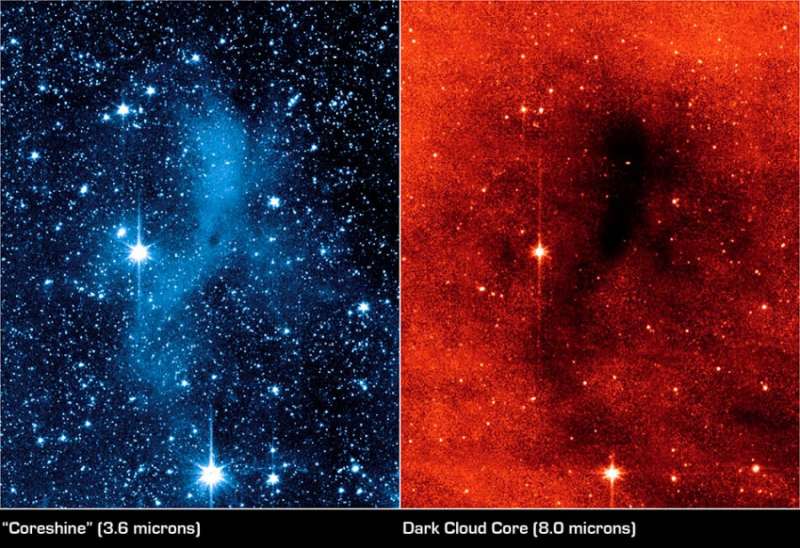Credit & Copyright: NASA,
JPL-Caltech,
Laurent Pagani (Obs.Paris/CNRS),
Jurgen Steinacker (Obs. Paris/MPIA)
et al.
Explanation:
Stars and their planets
are born in cold, dark, interstellar
clouds of gas and dust.
While exploring the clouds at
infrared wavelengths,
astronomers have made a surprising discovery -- dozens of cases
where dense cloud cores shine by reflecting
infrared starlight.
Based on archival
Spitzer Space Telescope
data, these panels illustrate the newly described phenomenon,
known as coreshine.
At longer infrared wavelengths (right) the core of
cloud Lynds 183
is dark, but at shorter infrared wavelengths
(left) the core clearly shines,
scattering light
from nearby stars.
As seen in these panels, the elongated core covers a mere 1.5 light-years.
The scattering requires dust grains that are about 10 times
larger than previously thought to exist in the clouds,
about 1 micron in size instead of 0.1 micron.
For comparison, a human hair is about 100 microns thick.
The larger dust grains indicated by coreshine could
change models of the early phases of star and planet formation,
a still mysterious process hidden
within the interstellar clouds.
Dark nebula Lynds 183 lies around
325 light-years away in the constellation Serpens.
1999 2000 2001 2002 2003 2004 2005 2006 2007 2008 2009 2010 2011 2012 2013 2014 2015 2016 2017 2018 2019 2020 2021 2022 2023 2024 2025 |
Январь Февраль Март Апрель Май Июнь Июль Август Сентябрь Октябрь Ноябрь Декабрь |
NASA Web Site Statements, Warnings, and Disclaimers
NASA Official: Jay Norris. Specific rights apply.
A service of: LHEA at NASA / GSFC
& Michigan Tech. U.
|
Публикации с ключевыми словами:
infrared - Spitzer space telescope - star formation - molecular cloud - инфракрасные наблюдения - звездообразование - Молекулярные облака
Публикации со словами: infrared - Spitzer space telescope - star formation - molecular cloud - инфракрасные наблюдения - звездообразование - Молекулярные облака | |
См. также:
Все публикации на ту же тему >> | |
Мнения читателей [3]
